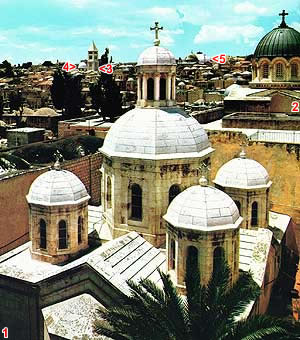 HOME | Jerusalem
environs | Jerusalem
c.30ce: northern aspect | Jerusalem
c.30ce: southern aspect | the Temple c.30ce |
for a meditation on the stations of the cross GO TO MIRFIELD
College
- excellent *****.
HOME | Jerusalem
environs | Jerusalem
c.30ce: northern aspect | Jerusalem
c.30ce: southern aspect | the Temple c.30ce |
for a meditation on the stations of the cross GO TO MIRFIELD
College
- excellent *****.  HOME | Jerusalem
environs | Jerusalem
c.30ce: northern aspect | Jerusalem
c.30ce: southern aspect | the Temple c.30ce |
for a meditation on the stations of the cross GO TO MIRFIELD
College
- excellent *****.
HOME | Jerusalem
environs | Jerusalem
c.30ce: northern aspect | Jerusalem
c.30ce: southern aspect | the Temple c.30ce |
for a meditation on the stations of the cross GO TO MIRFIELD
College
- excellent *****.
The Via Dolorosa (Latin: 'way of suffering') begins in the old Muslim quarter
of the city
and ends in the Church of the Holy Sepulchre.
It passes through
the Stations of the Cross, at which Christ's Passion is remembered.
The Gospels
mention only eight of the fourteen Stations which are passed through.
The
route has been frequently altered over the centuries.
Processions take place
every Friday at 3 p.m.
(Stations X to XIV are in the Church of the Holy Sepulchre):
| I | Pontius Pilate condemns Jesus to death. | The Pretorium | Matthew 27.22-26. |
| II | Jesus takes up the Cross. | The Way of Suffering | Mark 15.16-20. |
| III | Jesus falls under the weight of the Cross for the first time. | John 12.23-25. | |
| IV | Jesus meets his Mother. | Luke 2.22, 25, 34-35. | |
| V | Simon of Cyrene helps Jesus to bear the Cross. | Luke 23.26. | |
| VI | Veronica hands her sudarium to Jesus. | Matthew 25.25-36, 40. | |
| VII | Jesus falls under the weight of the Cross for the second time. | Isaiah 53.7. | |
| VIII | Jesus comforts the weeping women. | Luke 23.27-28. | |
| IX | Jesus falls under the weight of the Cross for the third time. | John 15.18-20. | |
| X | Jesus is stripped of His raiment. | Golgotha | Mark 15.22-24. |
| XI | Jesus is nailed to the Cross. | Luke 23.25, 49. | |
| XII | Jesus dies on the Cross. | Matthew 27.45-46. | |
| XIII | Descent from the Cross. | Mark 15.42-45. | |
| XIV | Entombment. | Mark 15.46-47. |
Crucifixion as a death penalty
originated in the Orient (Persia) and was mainly practised by the Carthaginians,
the Greeks and the Romans.
It was regarded
as a degrading and contemptuous means of execution.
Roman soldiers led Jesus
to his Crucifixion ( Mark 15.16-20).
According to St.John 19.17, He himself
carried His Cross to the place of execution,
but it is more likely that He -
following
Roman custom -
only carried the cross beam, because the whole Cross would have
been too heavy.
According to the Synoptists, Simon of Cyrene was compelled
to carry Jesus's Cross or its cross beam (Matthew 27.32).
Jesus was handed
an anaesthetic drink before the Crucifixion (Mark 15.23),
and after this
He was stripped of His raiment (Matthew 27.35)
and nailed to the Cross
(John 20.25).
Jesus was the first of the three crucified men to die, so
that it was no longer necessary to break His legs in order to bring about His
death (John 19.31-33), but one of the soldiers pierced His side with a
spear to determine whether He was really dead (John 19.34).
Christ's Cross may have been either
the Latin cross with arms of unequal length (Latin: 'crux imissa oblonga'),
the Greek cross with arms of equal length ('crux imissa quadrata').
It cannot,
however, have been the T-shaped Egyptian cross ('crux comissa') because
the superscription on the Cross was attached over Christ's head.
It is widely assumed that the Crucified Christ sat on a stake (Latin:
'sedile'), which was intended to prolong His agony.
The fact that one of the
bystanders put a sponge full of vinegar on a reed and intended to give it to
Jesus to drink (Matthew 27.48) suggests that His feet were about a yard
above the ground.
At His Crucifixion, the reason why He had been condemned
was, in accordance with Roman custom, written on a panel which was borne before
the condemned Christ on His way to execution and was attached to the Cross
above His head.
"And set up over his head his accusation written,
This is Jesus the King of the Jews"
Matthew 27.37.
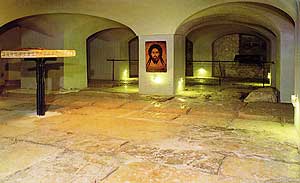 Station I:
Station I: The Via Dolorosa begins in the school yard of the Omar-iye Upper School for
Boys, where there is a good view of the Temple esplanade.
This building was
once a Turkish military barracks on the site of the Herodian Antonia fortress.
According to John 19, 13, Gabbatha (Hebrew: 'rising ground, elevation'),
in Greek 'Lithostrotos' = 'stone pavement', was the place of Pilate's judgement
seat where Christ was sentenced to death on the Cross.
It was either in the
Antonia fortress or in Herod's palace;
tradition locates it in the Antonia
fortress.
|
The Antonia castle occupied a strategically strong site to
the N. of the Temple.
It is first mentioned after the return from Babylonian
Captivity (Nehemiah 2.8:
'citadel of the temple' and Nehemiah 7.2: 'citadel'; cf. also 2 Maccabees
4.12-28; 5.5).
Christian tradition regards it as the place where Jesus was
condemned to death on the Cross.
The original building was destroyed in 167
BC by the Seleucids who built the Baris (= 'castle') in its stead.
King Herod
the Great enlarged the Baris into a splendid fortified palace with gorgeous
rooms, colonnaded halls, bath-houses and barracks.
He called this palace Antonia
in honour of his benefactor Mark Antony, the Roman triumvir.
This rectangular
building (330 x 490ft.) was on a rocky plateau 80ft. in height and falling
away steeply on all sides and dominating the Temple.
The largest of the four
towers in this fortified palace was 115ft. high;
steps led down to Temple
Square at two points.
It was suggested that Herod designed this building as
a 'tyrant's stronghold to oppress the people'.
The palace not only dominated
the Temple precinct but made it impregnable:
anyone wishing to capture the
Temple precinct first had to capture the Antonia fortress, which was itself
virtually impregnable.
During the period of the Roman procurators after the
death of Herod, there was always a Roman cohort in the Antonia fortress.
One
of its functions was to watch over Temple Square (Acts 21.31-40).
It is
uncertain whether the Antonia fortress was also the seat of the Roman governor
(praetorium):
"They then led Jesus from the house of Caiaphas to the Praetorium" John 18.28.
Christian tradition affirms this and regards one part of
the fortress as the place where Pontius Pilate, the Roman procurator, sentenced
Christ to death on the Cross.
During the First Jewish War, the Jewish rebels
seized the fortress (66ce) and put up a heroic resistance, but were starved
out and forced to surrender.
Titus, the Roman general who later became Emperor,
ordered the fortress to be razed (70ce).
top
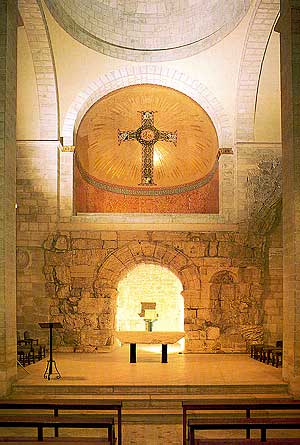 Station
II:
Station
II:A point opposite the Omariye school, marked by a board, is the
Second Station, where Jesus took up the Cross.
The Franciscan Chapel of the Flagellation,
to the right of Station
II was originally built by the Crusaders, fell into disrepair during Ottoman
rule, and was rebuilt in 12C style in 1929.
Scourging, that is to say whipping
with a cat-o'-ninetails or a knotted whip or with rods, was introduced into
Judaism under Roman-Hellenistic influence:
it is first mentioned in 2 Maccabbees
7.1 as having occurred in the period of the Seleucid ruler Antiochus IV Epiphanes
(160's bce).
In the area occupied by the Jews, scourging probably replaced
flogging with a stick, the punishment known from the Old Testament.
St. Paul
reports the following:
"Five times I had the thirty-nine lashes from the Jews;
three times I have been beaten with sticks."
2 Corinthians 11.24-25; another translation:
"Of the Jews five times received I forty stripes save one.
Thrice was I beaten with rods."
 Condemnation Chapel:
Condemnation Chapel: The Condemnation Chapel, which is also Franciscan, was
built by Wendelin
Hinterkeuser in 1903.
It stands on the foundations of a chapel in Byzantine
style.
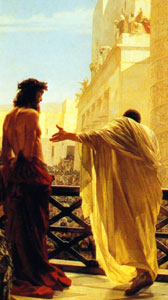 Ecce Homo arch:
Ecce Homo arch: After Christ had been scourged and crowned with the Crown of
Thorns, Pilate ordered Him to be brought forth to the Jews with the words 'Ecce
homo' = 'Behold the man!' (John 19, 5).
The arch is part of a gate from
Hadrian's time (2C AD).
Tradition has it that it spans the place where Pilate
ordered Christ to be brought forth to the Jews.
The N. arch of the Ecce Homo arch is part of the Ecce Homo
basilica (2nd half of 19C) which belongs to the French Sisters of Zion and
adjoins the Notre-Dame de Sion monastery.
top
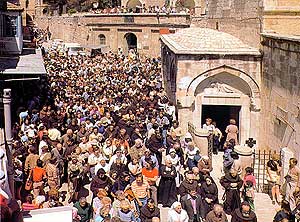 Station III:
Station III: The chapel by the 3rd Station was built by the Polish community
in 1947.
The arch above the door lintel shows Jesus falling under the weight
of the Cross.
The 'Chapel of the Swooning Virgin' (mid 20C) and the Armenian Catholic 'Church of the Virgin Mary's Sorrows' (1881) stand by the 4th Station, which commemorates Jesus encountering His mother, an event not recorded in the New Testament.
 Station V:
Station V: A Franciscan chapel dating from 1881 commemorates the site where
Simon of Cyrene helped Jesus carry the Cross.
In classical times the town of
Cyrene was rich and powerful and lay in the fertile district of Cyrenaica on
the N. coast of Africa (today it is in Libya).
It came under Roman rule in
96 BC.
top
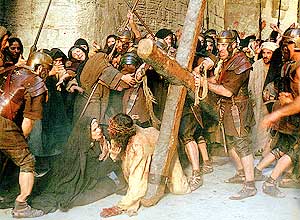 Station VI:
Station VI: Tradition has it that the chapel cared for by the Little Sisters
of Jesus stands on the site where a woman wiped Jesus's face with her napkin
(Latin: 'sudarium').
The monastery associated with the chapel is said to have
been built where her house stood.
Neither Veronica's sudarium nor Veronica
herself is mentioned in the Bible.
However, in the Roman Catholic church the
sudarium is revered as a valuable relic.
Legend has it that the pious Veronica
handed it to Jesus while on his way to His execution so that He might wipe
His face with it, thus leaving the imprint of His features on the cloth.
The
cloth was folded three times, and three identical imprints are thus supposed
to have been created.
It is said that one of these remained in Jerusalem, while
the other two went to Rome (St.Peter's basilica) and Jaen in Spain.
However,
some ten other towns claim to possess such imprints.
Vera Icon ('true image',
i.e. an image not painted by human hand) is the name given to these authentic
images of the face of the suffering Christ.
Hence it is often thought that
the name Veronica is a corruption of Vera Icon, although according to another
tradition the name Veronica derives from Berenike who, in the Jewish-Christian
legend of the Clementines, was the Canaanite woman's daughter healed by Jesus.
In the Acts of Pilate, and also in the works of Rufinus, Cassiodorus and Malalas,
Veronica is the name of the woman who suffered from haemorrhages, was cured
by Jesus and, according to Eusebius, dedicated a metal statue in Paneas to
Jesus.
The Veronica legend only dates back to c. 500 AD,
and is a Western variant
of the Oriental legend of Abgar from Edessa:
Abgar, king of Edessa, suffered
from an incurable disease and wrote to Jesus asking to be healed;
Jesus sent
a letter containing an imprint of His face on a linen cloth and thus restored
Abgar's health.
This so-called Edessa image was taken to Constantinople in
944 and is alleged to have arrived in Rome in 1204 after the Crusaders captured
Constantinople.
In Rome it was first kept in S.Silvestro in Capite and then
in the sacristy of St.Peter's from 1870 onwards.
The problem of the Veronica
image is that according to the legend it ought to show the face of the suffering
Christ bearing the Cross, whereas it actually gives a shadowy, pale imprint
of Christ after His death on the Cross.
The name 'Our Lord's napkin' or 'veronica'
is documented in Rome only from the late 13C onwards.
Miraculous napkins are
also mentioned in Acts 19, 12, where those of the Apostle Paul were taken from
him in Ephesus and used to cure the sick.
top
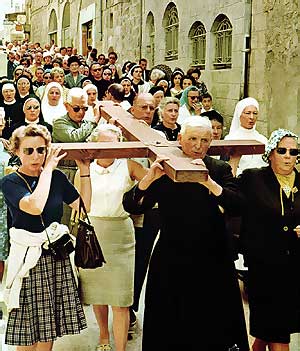 Station VII:
Station VII: A Franciscan chapel (1875) commemorates the second occasion when Jesus fell under the weight of the Cross.
A stone with a cross and the inscription 1C XC NIKA ('Jesus Christ is victorious') marks the point outside Jerusalem's walls where Jesus said to the lamenting women:
"Weep not for me,
but weep for yourselves, and for your children.
For, behold, the days are coming, in the which they shall say,
Blessed are the barren, and the wombs that never bare, and the paps which never gave suck.
Then shall they begin to say to the mountains:
Fall on us;
and to the hills, cover us."
Luke 23, 28-30.
A pillar marks the point where Jesus fell for the third time
under the weight of the Cross.
The remaining Stations of the Cross are in the
Church of the Holy Sepulchre.
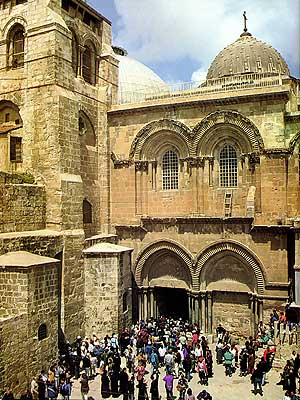 Church of the Holy Sepulchre:
Church of the Holy Sepulchre: The Church of the Holy Sepulchre stands above the place where Christ was
crucified, died, was entombed and rose again, and hence is one of the most
sacred Christian sites.
The last five Stations of the Via Dolorosa are inside this church.
Every Christian community tried to gain as much terrain as possible
for itself inside the Church of the Holy Sepulchre.
In 1852, the
Ottoman government therefore passed the 'Law of the Status Quo' which determined
their interests and is still in force today.
The whole Church of the Holy Sepulchre
and also the rotunda with the chapel of the Holy Sepulchre and the anointment
stone, belong jointly to the Greek Orthodox (patriarchates of Constantinople,
Alexandria, Antioch and Jerusalem), to the Armenians and to the Latins (Roman
Catholics);
only individual chapels belong to the Copts, Syrians and Ethiopians.
The area around the Golgotha rock was a place of reverence
for Christians as early as the 1C AD.
When the Roman Emperor Hadrian, after
the Bar Kochba revolt in 135, expelled all Jews from the city and built the
town of Aelia Capitolina on the site of the devastated Jerusalem, he also attempted
to destroy the Christian sites in order to blot out the memory of them.
The
ground of the sites of the Crucifixion and Resurrection was levelled and a
temple to Venus the goddess of love was erected.
Helena, mother of Emperor
Constantine the Great, visited the Holy Land in 326.
Makarios, Bishop of Jerusalem,
informed her that the sites of Jesus's death and resurrection were underneath
Hadrian's temple of Venus.
At Constantine's command, the temple was pulled
down and a basilica was built above the holy sites.
It was consecrated in 335
as 'Anastasis', meaning church of the Resurrection.
The basilica was destroyed
by the Persians in 614 and later rebuilt.
The Caliph al-Hakim systematically
destroyed it again in 1009, when even the sepulchre was almost completely torn
down.
The new structure built by the Crusaders was dedicated in 1149. ...
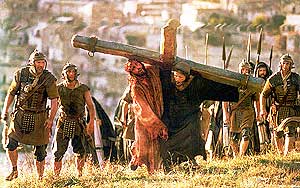 Golgotha:
Golgotha: The Golgotha rock above the Adam chapel contains Stations
X - XIII of the Via Dolorosa:
top
Jesus is stripped of His raiment;
 Station XI:
Station XI:Jesus is nailed to the Cross;
Jesus dies on the Cross;
top
Jesus's body is laid in His mother's lap.
The
name Golgotha (probably from the Aramaic gulgulta = 'skull') is interpreted
by the Evangelists as meaning 'place of a skull' (Matthew 27.33; Mark
15.22; Luke 23.33; John 19.17).
This is the place where Jesus died
on the Cross.
 The name 'Mount Calvary' derives from the Latin calvaria = 'brain
case, skull').
The name 'Mount Calvary' derives from the Latin calvaria = 'brain
case, skull').
The explanation which the Greek writer Origenes (3C AD) and
a Jewish tradition give for the name is that Adam's skull was found here and
Adam was buried here (cf. Adam chapel, above).
But Jerome, the Latin Father
of the Church (4-5th.cent.), derives the name from the skulls of the persons
buried there.
The most probable interpretation is that Golgotha was a skull-shaped
hill outside the city walls of Jerusalem and was used as a place of execution
and burial.
The mosaics and paintings at the individual altars of Golgotha (including a
16th cent. altar table, donated by Fernando de'Medici, the Tuscan Grand Duke)
depict events recorded in the Gospels and Apocrypha.
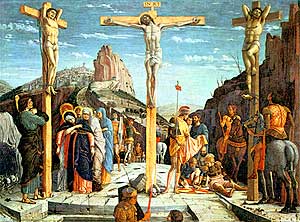 The
Crucifixion, being the central event in the life of Christ, developed into
the main theme of Christian iconography.
The
Crucifixion, being the central event in the life of Christ, developed into
the main theme of Christian iconography.
On the altars, the Crucifixion occupies a central position and is proportionately
larger than the scenes which surround it on either side -
the Passion (on the
left) and the scenes after the Crucifixion, from the Deposition to the appearances
of the Risen Christ (on the right).
Death by crucifixion was regarded as the
most disgraceful form of execution,
and for this reason reference to it was
avoided in early Christian painting;
neither was Christ depicted as suffering,
but as living after death and triumphing on the Cross.
This image of God who,
through the Cross, overcame death and triumphed prevailed up until the Romanesque
period.
In Gothic art, the suffering or dead Christ was emphasized.
He wore the Crown
of Thorns instead of the ruler's crown,
and the four nails were replaced by
three nails with the feet penetrated by a single nail.
The head, previously
raised in majesty, appears inclined to one side and distorted with pain.
This
suffering was still more drastically depicted in the 14C, under the influence
of mysticism.
At the same time, narrative elements filled the picture.
The
'Crucifixion' became 'Mount Calvary',
and the place of execution was crowded
with curious onlookers.
Leaving Golgotha, the visitor passes the anointment stone and enters
the rotunda.
Its dome, some 165 ft. high, spans Christ's sepulchre.
The masonry
of the rotunda is Constantine up to a height
of about 35ft. (4C); the section above is 11C.
top
 Matthew
27.59-60 relates that, after the Crucifixion, Jesus was laid in a rock tomb,
which had yet to be used and which belonged to Joseph, a rich man of Arimathaea.
Matthew
27.59-60 relates that, after the Crucifixion, Jesus was laid in a rock tomb,
which had yet to be used and which belonged to Joseph, a rich man of Arimathaea.
A stone was rolled in front of the tomb
after Jesus had been interred.
The tomb was in a garden near the place of Crucifixion
(John 19.41).
The 'very great' stone closing the tomb entrance must have
been round, because it was possible to roll it (Mark 16.3-4).
It was
necessary to lean forwards in order to look into the burial chamber (Luke
24.12; John 20.5-11), which means that the opening to the tomb must have
been low.
When the women discovered the empty tomb after the Resurrection,
two angels were sitting in the burial chamber
"the one at the head,
and the other at the feet,
where the body of Jesus had lain"
John 24.12; cf. Mark 16.5-6,
thus implying it was a bench-type tomb.
According to John 19.17-20, Jesus was crucified outside the city wall.
The present Church of the
Holy Sepulchre is inside the city wall, as in 41ce, Herod Agrippa ordered
a wall to be built around the N. of Jerusalem, taking in Golgotha and Joseph
of Arimathaea's tomb.
The sepulchre of Christ shown in the Church of the Holy Sepulchre is not regarded
as authentic by Anglicans, who consider that Christ's real burial site is the
so-called garden tomb, which is located not far from the Damascus gate, outside
the present city wall.
This structure hewn from the rock has two chambers and
was built at about the beginning of the Christian era.
Above Christ's sepulchre rises a kiosk (1810) in Turkish rococo style, 27ft
long, 19½ft wide and 19½ft high.
The lamps hanging in front of the
portal belong to the Latins (top row), Greeks (middle rows) and Armenians (lower
row).
The portico of the burial chamber is called the angel chapel because
tradition has it that the angels who announced to the women that Christ had
risen were sitting here.
The body of Christ lay in the burial chamber proper,
on the bench which is now faced in marble. ...
A part of the rock tomb is to be seen at the altar of the chapel on the rear side of the Holy Sepulchre. ...
A small passage leads to the tomb of Joseph of
Arimathaea.
This is a Jewish burial chamber from the 1st cent.ce (the only items
surviving in their entirety are two sliding posts) next to the chapel of the
Jacobites.
Joseph, a rich man from Arimathaea (Matthew 27.57) was a highly
regarded member of the Jewish High Council (Mark 15.43) and is described
in the New Testament as a good and just man (Luke 23.50).
He was a disciple
of Christ, but only secretly, for fear of the Jews (John 19.38).
After
the Crucifixion, he requested Christ's body from Pilate and ordered it to be
buried in the rock tomb which he had enlarged for himself and which lay outside
Jerusalem (Matthew
27.57-60; Mark 15.42-47; Luke 23.50-56; John 19.38-42).
ILLUSTRATIONS adapted as follows:
"The
Holy Land," by
Sami Awwad, (page 76). Golden Printing Press, Jerusalem, 1997.
"In the footsteps of Jesus," W E Pax, Nateev printing & publishing
ent.Ltd., 1970.
The Illustration opposite 'Antonia fortress' is of part of the 1/50th scale
model by the late Prof. Avi Yonah of the Hebrew University, in the Holyland
Hotel, Jerusalem.
"The Passion," ed: Bon Steffen, Icon
Dist.Inc, 2004.
COMMENTARY: "Jerusalem and the Holy Land," ed.Dr.
Marianne Mehling, Phaidon,
1987.
top